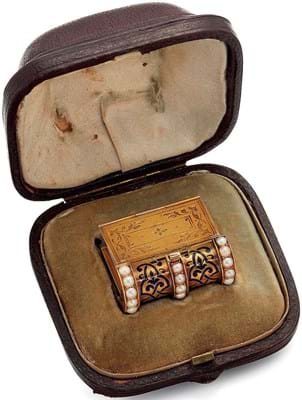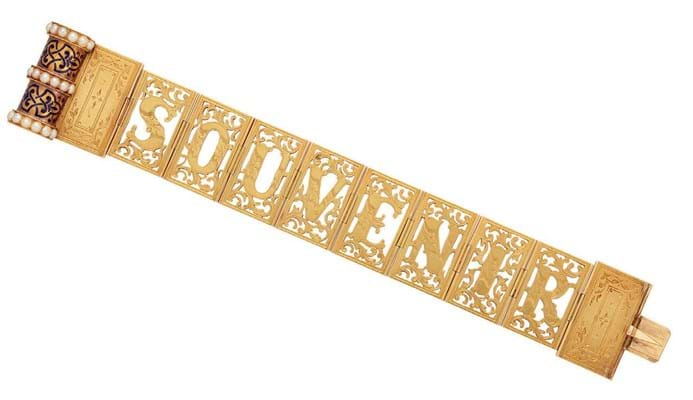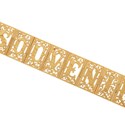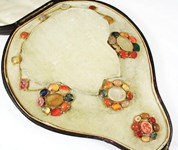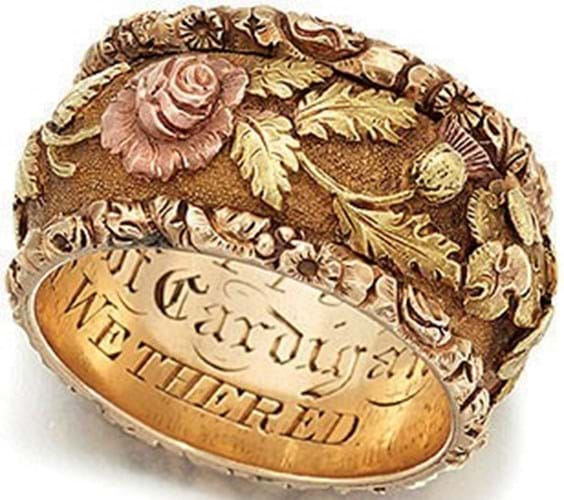
He had (perhaps incorrectly) received an order to send the 670 troopers under his command to attack over 50 Russian guns in what Tennyson would call the Valley of Death. The cost of the ‘Charge of the Light Brigade’ was 107 lives.
Lord Cardigan was the caricature of the Victorian army officer. Educated at Harrow and Oxford and an MP for Marlborough at 21, his military career was marked by moments of extraordinary incompetence but also great bravery and generosity to his men.
Among those who chose to be remembered to his former officer was one Captain Wethered, who gave Cardigan a heavy three-colour gold ring decorated with the rose, thistle and shamrock of the union.
Inside it was inscribed A Tribute of Gratitude to the Rt Hon’ble the Earl of Cardigan, from Capt GT Wethered. A painting by Woolwich artist Richard Buckner (1812-83) shows Lord Cardigan wearing the ring, suggesting it was a treasured gift. It was later given or bequeathed by Lord Cardigan to his nephew George Augustus Frederick Louis Curzon-Howe, then Lord Curzon later 2nd Earl Howe, 1821-76.
It came via descent from Lord Howe’s only child (Lady) Harriet Alice for sale at Roseberys London (25% buyer’s premium) on March 19. Probably dating from c.1840 – around the time Cardigan inherited the earldom and the extensive family estates from his father – it received plenty of interest on its first-ever auction appearance before selling at £8800 (estimate £2000-3000).
Welcome wearability
So much antique jewellery is inherently wearable – a welcome antidote to the homogeneity of so many high street jewels. However, there are antique pieces that are acquired simply to admire for their design, craftsmanship and historical significance.
Sold in the same sale at £4600 (estimate £2000-4000) was a gold, diamond and enamel mourning ring commemorating the death of a well-known Georgian beauty.
So much antique jewellery is inherently wearable – a welcome antidote to the homogeneity of so many high street jewels
Offered in its original box, the bezel featured a funerary urn motif centred on a pear-shaped old-brilliant-cut diamond, while engraved to the hoop was the legend To the My of AM Countess of Dysart 14 Sept 1804. It included a lock of her hair.
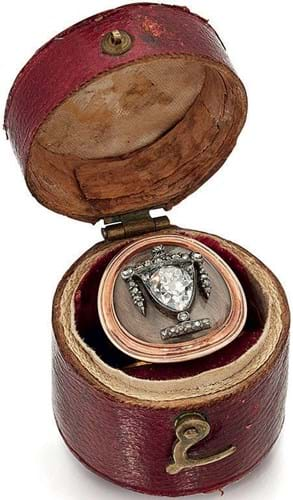
A gold, diamond and enamel mourning ring commemorating the death of Anna Maria Tollemache – £4600 at Roseberys.
The Countess of Dysart was Anna Maria Tollemache (1745-1804), a Solihull girl who married the Northampton MP Wilbraham Tollemache, 6th Earl of Dysart (1739-1821).
Painted by several artists of the day, including John Constable, her portrait as the Shakespearean character Miranda by Sir Joshua Reynolds was published as a mezzotint in 1786.
Another popular ‘collector’s’ lot was a fine-made Victorian gold, champlevé enamel and pearl ‘book’ bracelet. Composed of a series of panels each pierced and engraved with a letter spelling souvenir, it folded to form a miniature book with the dark blue enamel clasp modelled as the spine. Dating from c.1845, it sold in its original fitted case for £3400, a multiple of the £600-800 estimate.
A gold, enamel and calibre sapphire and diamond pendant by Masriera sold at £3800.
Having witnessed the triumph of Art Nouveau at the 1900 Exposition Universelle in Paris, Lluis Masriera returned to Barcelona and set about completely reinvigorating his firm’s jewellery designs, selling old stock and wholeheartedly embracing the new aesthetic. This pendant c.1910-20 – worked with two peacocks perched on a fountain – demonstrates a mastery of plique-à-jour enamel.
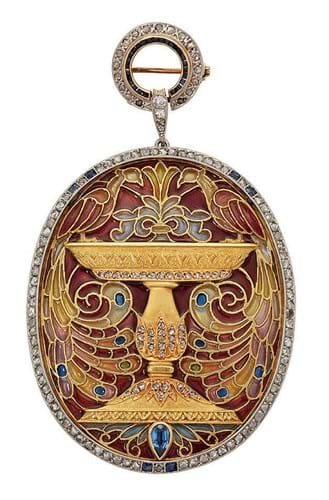
A gold, plique-à-jour enamel and calibre sapphire and diamond pendant by Masriera – £3800 at Roseberys.
A typical example of French Art Nouveau, a gold ring modelled in high relief with the despairing figure of Eve with the serpent at her feet, sold at £2200. It was probably by sculptor and founder Paul Louchet (1854-1936).


